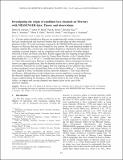| dc.contributor.author | Hurwitz, Debra M. | |
| dc.contributor.author | Head, James W. | |
| dc.contributor.author | Byrne, Paul K. | |
| dc.contributor.author | Xiao, Zhiyong | |
| dc.contributor.author | Solomon, Sean C. | |
| dc.contributor.author | Zuber, Maria | |
| dc.contributor.author | Smith, David Edmund | |
| dc.contributor.author | Neumann, Gregory A. | |
| dc.date.accessioned | 2014-03-20T19:15:34Z | |
| dc.date.available | 2014-03-20T19:15:34Z | |
| dc.date.issued | 2013-03 | |
| dc.identifier.issn | 21699097 | |
| dc.identifier.uri | http://hdl.handle.net/1721.1/85854 | |
| dc.description.abstract | Volcanic plains identified on Mercury are morphologically similar to lunar mare plains but lack constructional and erosional features that are prevalent on other terrestrial planetary bodies. We analyzed images acquired by the MESSENGER spacecraft to identify features on Mercury that may have formed by lava erosion. We used analytical models to estimate eruption flux, erosion rate, and eruption duration to characterize the formation of candidate erosional features, and we compared results with analyses of similar features observed on Earth, the Moon, and Mars. Results suggest that lava erupting at high effusion rates similar to those required to form the Teepee Butte Member of the Columbia River flood basalts (0.1–1.2 × 106 m3 s–1) would have been necessary to form wide valleys (>15 km wide) observed in Mercury's northern hemisphere, first by mechanical erosion to remove an upper regolith layer, then by thermal erosion once a lower rigid layer was encountered. Alternatively, results suggest that lava erupting at lower effusion rates similar to those predicted to have formed Rima Prinz on the Moon (4400 m3 s–1) would have been required to form, via thermal erosion, narrower channels (<7 km wide) observed on Mercury. Although these results indicate how erosion might have occurred on Mercury, the observed features may have formed by other processes, including lava flooding terrain sculpted during the formation of the Caloris basin in the case of the wide valleys, or impact melt carving channels into impact ejecta in the case of the narrower channels. | en_US |
| dc.description.sponsorship | United States. National Aeronautics and Space Administration (NASA Discovery Program under contract NAS5-97271 to The Johns Hopkins University Applied Physics Laboratory) | en_US |
| dc.description.sponsorship | United States. National Aeronautics and Space Administration (NASA contract, NASW-00002 to the Carnegie Institution of Washington) | en_US |
| dc.language.iso | en_US | |
| dc.publisher | American Geophysical Union | en_US |
| dc.relation.isversionof | http://dx.doi.org/10.1029/2012je004103 | en_US |
| dc.rights | Article is made available in accordance with the publisher's policy and may be subject to US copyright law. Please refer to the publisher's site for terms of use. | en_US |
| dc.source | MIT web domain | en_US |
| dc.title | Investigating the origin of candidate lava channels on Mercury with MESSENGER data: Theory and observations | en_US |
| dc.type | Article | en_US |
| dc.identifier.citation | Hurwitz, Debra M., James W. Head, Paul K. Byrne, Zhiyong Xiao, Sean C. Solomon, Maria T. Zuber, David E. Smith, and Gregory A. Neumann. “Investigating the Origin of Candidate Lava Channels on Mercury with MESSENGER Data: Theory and Observations.” Journal of Geophysical Research: Planets 118, no. 3 (March 2013): 471–486. . | en_US |
| dc.contributor.department | Massachusetts Institute of Technology. Department of Earth, Atmospheric, and Planetary Sciences | en_US |
| dc.contributor.mitauthor | Zuber, Maria | en_US |
| dc.contributor.mitauthor | Smith, David Edmund | en_US |
| dc.relation.journal | Journal of Geophysical Research: Planets | en_US |
| dc.eprint.version | Final published version | en_US |
| dc.type.uri | http://purl.org/eprint/type/JournalArticle | en_US |
| eprint.status | http://purl.org/eprint/status/PeerReviewed | en_US |
| dspace.orderedauthors | Hurwitz, Debra M.; Head, James W.; Byrne, Paul K.; Xiao, Zhiyong; Solomon, Sean C.; Zuber, Maria T.; Smith, David E.; Neumann, Gregory A. | en_US |
| dc.identifier.orcid | https://orcid.org/0000-0003-2652-8017 | |
| mit.license | PUBLISHER_POLICY | en_US |
| mit.metadata.status | Complete | |
